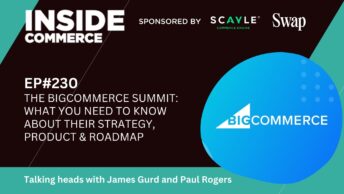In this ecommerce podcast, James and Paul provide their take on what’s been happening with leading ecommerce vendor product and go-to-market strategies during the last 12 months.
Listen on your favourite player
Watch the video
Our podcast is deliberately technology and vendor agnostic, and our goal is to help you better understand the ecommerce technology landscape. For our final episode of 2022 we dive into the current ecommerce platform market to look at key vendors and discuss what’s been happening with their product and go-to-market strategy in the last 12 months.
We cover among others Shopify, BigCommerce, Optimizely, Elastic Path, Commercetools, Oro, Shopware and Remarkable Commerce. Please note it’s not an exhaustive market review, there are so many players and we did reach out to a few others for their input but didn’t get a reply in time to include them.
Tl;dr
- How has the vendor’s product strategy changed during 2022 and why?
- What are the top 3 product features each vendor added during 2022?
- What has been the biggest customer account win of 2022?
- Where the roadmap focus is headed in 2023
Key discussion points
Shopify
- B2B functionality
- Improvements to markets – URLs, API endpoints, better multi-language etc
- Markets Pro
- Improvements to Hydrogen, but unknowns here
- 2.0 improvements – search, filtering etc
- Improvements in some of these areas, e.g. tags for filtering
- Acquisitions – dovetale
- Checkout extensions / apps
- Web3 features
- Social commerce – TikTok and Twitter being the latest ones + bought Linktree equivalent
- POS improvements – Inc iPhone tap to pay
- Functions for back end
- Various other things such as ERP integrations phase one, new CMS piece etc
BigCommerce
Strategy:
- In past few years moved upmarket in aim to be the most modern ecommerce platform for enterprise merchants.
- Tech improvements such as moving API to GraphQL for better performance, extending the ecosystem through tech integrations and strong partnerships e.g. adding Advanced Commerce for search & merch
Top 3 product features
- MSF enabling merchants to manage multiple B2C and B2B online businesses from a single BigCommerce dashboard and reduce operational costs and complexities; now adding compatibility with Bundle B2B
- Multi-Location Inventory APIs in beta, managing product inventory across one or many locations such as owned warehouses, logistic providers, brick-and-mortar stores when selling via various channels
- Feedonomics for enterprise data feeds direct out of BC, helpful when you don’t have a PIM that can provide custom data for shopping, social, marketplaces etc.
Biggest customer win
- Ted Baker, the UK-based global lifestyle brand, is arguably the most significant because it is built on BigCommerce’s MSF headless solution.
- Ted Baker uses a single BigCommerce store to operate 12 unique regional storefronts
- regional storefronts are fully localized to enable the luxury fashion retailer to meet the needs of its expanding customer base. Shoppers can browse in their preferred language such as English, French, German and Spanish
2023 roadmap focus
- Expand our MLI capabilities, including adding buy online, pick up in store (BOPIS) functionality
- Add functionality to Multi-Storefront and integrate MSF into B2B Edition solution, which is a big win as previously to do B2B effectively on MSF you’d need to go headless and use an alt like JMango
Centra
- Some big wins – gradually coming into the UK market.
- Product management capabilities for fashion products – enriching the product data model in Centra towards becoming a full ecom PIM
- New admin interface. The focus has been on maximizing power user productivity in a desktop environment, with high density tables, powerful search and filtering and many batch actions for carrying out activities in bulk.
- wholesale self-service adoption
- Launched native subscription support.
- We launched a native Klaviyo integration – We’ve had many customers using Klaviyo for many years, integrating the APIs of Centra and Klavyo.
Optimizely
Strategy:
- After a couple of years of M&A, overall strategy is emerging where we have products and platform services; products are things that more cleanly fit into a category such as commerce, CMS, experimentation, platform services are capabilities that sit across, CDP being an example, workflow being another example.
- Before we used to build everything within each product, now we have horizontal layers as services where there are common things, and each product embeds it to deliver value faster at scale to multiple personas.
Top 3 product features
- Real Time Segmentation – Adjust targeting and automations in seconds and not hours.
- Customized Commerce APIs – Customers can leverage core commerce functionality in non-web experiences
- Configured Commerce Mobile SDKs – Allowing customers to build great app experiences faster and at lower TCO
Biggest customer win
- A national pet food distributor, supplies large selection of high-quality brands to fit the specific needs of your business and customers
- US customer – Had a custom solution that wasn’t meeting their needs – poor performance, search issues, lots of orders/returns still occurring through email. They choose Optimizely’s Configured Commerce tool along with our integrated PIM solution to increase engagement, reduce cost to serve, and ease of use, both internally and for their retailers
- They also wanted a commerce platform that could scale and grow with them as a business. Migrated from Infor Storefront & custom commerce solution.)
2023 roadmap focus
- Across 2023 a much more cohesive platform experience, going seamlessly from capability to capability.
- Many more opinionated integrations between products, e.g., CDP and platform wide workflows across Commerce, CMS and Experimentation
Shopware
Thanks to Justin Biddle, heads up UK strategy and bus dev
Strategy:
- The economic/supply challenges of 2022 led Shopware to focus on enhancing operational efficiency. Many of the features delivered this year streamline admin workflows (e.g. intelligent, configurable admin search, enhancements to bulk operations)
- No-code Flow Builder facilities empower admins to deeply segment customers and customer groups and trigger various workflows and operations right within the admin interface.
- Market positioning changes (new product packages – Community, Rise, Evolve and Beyond), and from a geographical (especially as regards the UK) point of view.
- Recent investment round with Carlyle and PayPal has allowed new US momentum
Top 3 product features
- Flowbuilder: takes Shopware’s rule builder functionality and adds event triggers and actions to them. Use-cases are growing but as an example you can create VIP Workflows, custom order management workflows, segmentation & loyalty and even third party integration.
- Apps, Plugins & Private Apps: March introduced “private apps” to Shopware Cloud, SaaS version of Shopware 6, providing near-limitless local customization. This capability was further enhanced in May with the release of “app scripting” which allows substantial customization without the need for an additional hosting environment.
- Customer Specific Pricelists: Shopware 6 has always allowed merchants to set customer specific prices, based on rules, but this has been designed as a solution to ‘outlier’ prices, and is not ideal for scenarios where all customers have their own pricelists for all products. In December released customer-specific price lists, which allows whole pricelists to be easily utilized – and hence delivers a performant solution to this crucial B2B requirement.
Biggest customer win
- Zwilling (www.zwilling.com). They are migrating their B2B infrastructure away from Salesforce, and have launched the Netherlands store already, with US & Canada, Brazil, China, Nordics and the rest of Europe to follow next year.
2023 roadmap focus
- Range of B2B enhancements, subscriptions and an improved returns management infrastructure all coming
- Most important roadmap item for next year is undoubtedly Multi Source Inventory (MSI).
- This gives the ability to define stock by geographic location and allowing for more efficient stock and shipping strategies. It is a key pillar in our omnichannel vision for Shopware.
Remarkable
Thanks to Brad Houldsworth, Head of Strategy
Strategy:
- Primary vision for our platform has been focused on building frontend functionality for our client’s customers to engage with – such as product configurators, subscription payment functions, hero products within PLPs and adding new layout options for our standard checkout flow (see Moss.co.uk) and PDP design (see Pragnell.co.uk). But we have also built lots of admin functionality (3 examples added below).
- clients ultimately own their own product roadmap, for their versions of the platform, however, we are constantly reviewing all of the new functionality we’re creating and how ‘global’ it could be, and whether it should be added into our core solution.
- Strategically, we are positioning the platform as the most customisable on the UK market and really leaning into our agility for B2C retailers.
Top 3 product features
- CMS Module: An in-built asset management library.
platform now includes a DAM library, which collects all images/videos/assets uploaded into the platform, indexes them and allows them to be used across all modules. Example: A product video is uploaded into the platform FTP, and auto assigned to a product. This video is now shown within the DAM and a user can then add this video into a CMS page.
- Merchandising Module: Retailing sub-groups/zones of items within a PLP.
Giving the client the ability to have multiple retailing rule sets running on the same PLP. Example: A ‘new-in’ category, could have all t-shirts listed first, and retailed by CTR data. Followed by all jeans, which are retailed by stock availability. Followed by jackets, which are retailed by price low>high.
- Social Proofing function: The ability to add social proof messaging onto PLP/PDP.
took inspiration from 3rd parties (like Taggstar) and built a fully admin-driven function, allowing retailers to write their own dynamic message, and assign it to appear on particular PLPs or PDPs (assigning individually, or in bulk).
Biggest customer win
- Westbrook Cycles re-platformed to Remarkable this year, moving away from Visualsoft who they were with for over 10 years. They attempted a migration to an alt platform but abandoned the project after 3 months, was unable to handle their supplier feed requirements (exposing a Rest API with complex field logic, and creating email ‘drop box’ for product files to be sent, and imported directly into the platform) – which Remarkable able to do very easily.
Key stats seen within 30 days of migrating were:
- +60% year-on-year AOV uplift
- +130% year-on-year revenue uplift
- +200% year-on-year Organic traffic growth
- +15% increase in page speed / decrease in load time
- +40% increase in session duration
2023 roadmap focus
- Personalisation in-built into the platform, enabling the following abilities:
- Dynamic content based on traffic referrer source/channel
- Product recommendations solution
- Loyalty solutions, with VIP and reward schemes, tiered based on custom variables
- Extending our Automation capabilities into additional modules, like Promotions (e.g. automating a trigger launch/pause of campaigns based on performance data)
Adobe Commerce:
- Some minor features as part of the continued 2.4 releases
- Some minor B2B features
- Continued focus on the Adobe products
- B2B new features – inc improved approval workflows
- In-Store Pickup added
- Media gallery improvements
- increasing GraphQL API coverage – particularly for B2B
- Performance improvements
- Hyva is something that’s getting bigger that I’m keeping an eye on
Oro
Thanks to Chris Raven, UK Director at Oro Inc. for providing the update.
Strategy:
- Our product vision shifted to serve the changing dynamics of the B2B landscape. Global appetite for a marketplace proposition satisfied with Oro Marketplace
- From a product strategy standpoint, refining and bolstering the customer experience, improving performance and useability e.g. ability to order faster, better search, faster API’s & productivity.
Top 3 product features
- launched marketplace module, built from groundup for B2B with built-in CRM, giving customers more flexibility in deploying their propositions to live
- Enhanced native search engine to let customers download and fllter search results, alert customers to changes in saved searches e.g. pricing, restock
- Core improvements to performance and productivity including revamping storefront assets, namely JavaScript, and optimized server response time, adding support for WebP images
Biggest customer win
- Dunlop
- “We leaned heavily on OroCommerce’s comprehensive native B2B features, which enabled the rollout of a high-quality, mission-appropriate backend and frontend deployment with very little need for customization now or in future”
2023 roadmap focus
- Improved multi-organization management for B2B2B and B2B2C, and multi-vendor commerce scenarios
- Improving customer stickiness and AOV with better front-end UX, improved product kitting, and product bundling capabilities
- Improved search controls and reporting for better marketing and merchandising on the storefront
- The biggest feature for our customers is likely to be relating to Product Bundling and Kitting; create individual SKUs for each kit or bundle or treat them as a collection of products with their respective SKUs
Want to suggest a topic or guest for a future episode? Contact us via the website or on Twitter.





